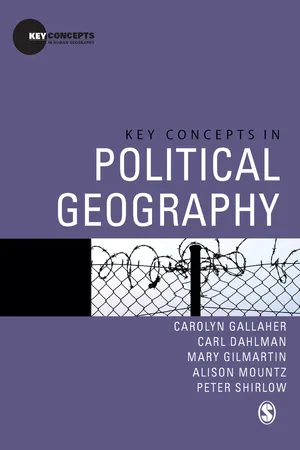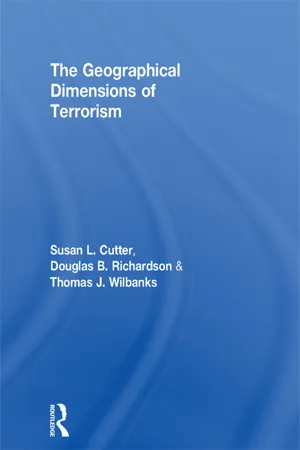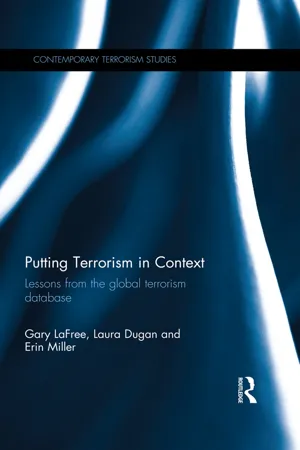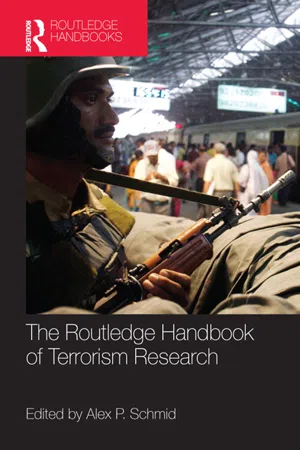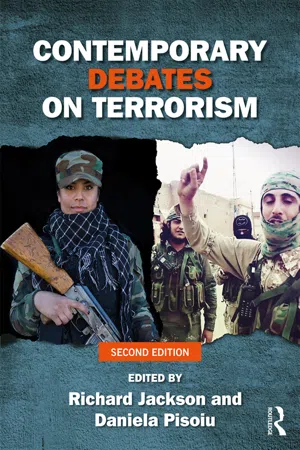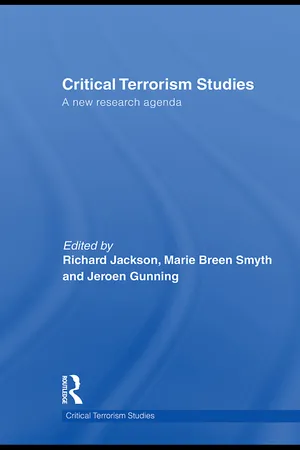Geography
Terrorism
Terrorism refers to the use of violence, intimidation, or coercion for political or ideological purposes. It often targets civilians and is intended to create fear and disrupt normal life. The geographical aspect of terrorism involves analyzing its spatial patterns, distribution, and the impact of terrorism on different regions and landscapes.
Written by Perlego with AI-assistance
11 Key excerpts on "Terrorism"
- eBook - ePub
- Carolyn Gallaher, Carl T Dahlman, Mary Gilmartin, Alison Mountz, Peter Shirlow(Authors)
- 2009(Publication Date)
- SAGE Publications Ltd(Publisher)
Terrorism – is discussed. Terrorism is a loaded term in that there is no readily agreed upon definition of the word. At a base level, geographers (and other social scientists) view Terrorism as a tactic of war designed to intimidate a civilian population. While Terrorism is often described as a random event, geographers note that there are distinct spatial patterns in the distribution of terrorist attacks.In the final chapter of this part a particular type of conflict – anti-statism – is considered. Anti-statism refers to internal assaults (verbal or physical) by citizens on the state in which they live. The goal of anti-statism is to dismantle the state. However, unlike a traditional guerilla war where the goal is to replace one state structure with another, anti-statists usually want to divest a state of power and move it to smaller scales, such as provincial or even local jurisdictions.Conflict can and does occur at various scales. The examples used in these chapters follow a similar pattern. The conflicts covered include contestations over who can march in the New York St Patrick’s Day parade, battles to get the federal government out of Kentucky, and wars in the Great Lakes region of Africa. The aftermath of conflict in Bosnia is also considered.Passage contains an image
19 CONFLICT
Mary GilmartinDefinition: In Wartime and in Peacetime
In broad terms, conflict results from the pursuit of incompatible goals by different people, groups or institutions. Often, people consider conflict as violent, but this is not necessarily the case. Conflict can take place through peaceful means as well as through the use of force, though violent conflict often receives most attention.When we consider conflict that takes place using force, there are a number of distinctions to be made. An armed conflict involves the use of force by all parties in a conflict, though this varies from an attack by a single soldier to an all-out war with multiple casualties. Conflict that involves the use of force by a state or by an organized group against civilians (such as massacres and genocide) is sometimes described as one-sided violence (Eck et al. 2004). Terrorism is also a form of conflict. Terrorists hope to secure goals by intimidation, by using or threatening to use violence against governments, groups and even individuals. (For more information on Terrorism see Chapter 21 - eBook - ePub
- Susan L. Cutter, Douglas B. Richardson, Thomas J. Wilbanks(Authors)
- 2014(Publication Date)
- Routledge(Publisher)
One can and should draw distinctions between all of these movements and what happened on September 11, 2001, but to date there has been little effort to stake out where and how those distinctions might be drawn. Focusing attention on the spatial dimensions of Terrorism can help in this regard, for meaningful distinctions among and between violent insurgencies cannot be made without consideration of the contexts out of which violent antisystemic movements emerge, and the circumstances under which particular violent actions are perpetrated. Taking the spaces of Terrorism seriously is thus important not only for understanding the development of particular problems; it can help clarify the normative foundations on which future policies can and should be based.3.2 GEOGRAPHIES OF INCLUSION/EXCLUSIONCOLIN FLINTTHIS ESSAY EXPLORES one component of the root causes of Terrorism, the processes that create a binary of inclusion/exclusion and the spatial manifestation of that binary—the geography of inclusion and exclusion. Inclusion and exclusion refer to control over access to political institutions (such as state citizenship), acceptance in particular identities (the American nation, for example), plus the ability to participate in the economic livelihood of the place. The geography of inclusion/exclusion refers to the way borders and the territories they define facilitate both participation and membership in identifiable groups, as well as noninvolvement and exclusion. For example, political borders and sovereign territory define insiders and outsiders (into such categories as citizens and aliens) by controlling mobility. Economic development may facilitate wealth generation by some groups (citizens), while impoverishing others by altering access to land or capital, for example.The attacks of 9/11 were the most deadly in a series of terrorist acts that changed the relevant scale of inclusion/exclusion from the nation-state to the global geopolitical system. In other words, national separatism no longer appeared to be the main motivator of Terrorism. Rather, it was reaction to the norms and geographies of the global geopolitical system that was the root causes of this Terrorism. - eBook - ePub
- Gary LaFree, Laura Dugan, Erin Miller(Authors)
- 2014(Publication Date)
- Routledge(Publisher)
4 The spatial distribution of Terrorism around the world and in the United StatesTerrorism is a scourge that affects all of us, regardless of region or religion.UN Secretary-General Kofi Annan1Terrorism, like viruses, is everywhere. There is a global profusion of Terrorism, which accompanies any system of domination as though it were its shadow, ready to activate itself anywhere, like a double agent.Jean Baudrillard, The Spirit of Terrorism , 20022The ubiquity of modern media means that individuals are now routinely bombarded with disturbing images of terrorist attacks from around the globe. This blanket coverage of high-profile events such as those that have occurred in New York City, Madrid, London, and Mumbai leave the impression that no location on the planet is safe from Terrorism. But in fact, our analysis of the Global Terrorism Database (GTD) shows that terrorist attacks are highly concentrated in relatively few locations. Major regions of the world differ enormously in terms of how common Terrorism has been and the lethality of its impact. Moreover, the regional distribution of Terrorism has changed a good deal over the past four decades. Although the terrorist attacks in the GTD have occurred in 210 different countries and territories, many regions, countries, and cities of the world have had few or no terrorist attacks since the GTD data collection began in 1970. Many other regions, countries, and cities have had large numbers of attacks, and these patterns have often changed substantially over time.The geographic concentration of Terrorism also encourages stereotypes regarding the areas of the world where Terrorism is most likely to flourish. Given the enduring impact of 9/11 and the origins of the 9/11 attackers, it is easy to see Terrorism as a problem that is especially tied to the Middle East/North Africa and South Asia. Indeed, as we shall see below, since 9/11 a large number of terrorist attacks and fatalities have taken place in these regions. But if we take a broader, more historical look at the spatial distribution of Terrorism, we quickly realize that this association is also overly simplistic. While the Middle East/North Africa and South Asia regions have witnessed a good deal of Terrorism since the turn of the twenty-first century, attacks in these regions were far less common in earlier decades, and since 9/11 several other regions of the world have also witnessed large increases in terrorist attacks. - eBook - ePub
- Alex Schmid, Alex P. Schmid(Authors)
- 2011(Publication Date)
- Routledge(Publisher)
771978 HamiltonFor the purposes of this study, the following definition will be used: Terrorism consists of (1) planned acts of violence, employed for (2) explicitly political purposes, ultimately directed against (3) an established state or organizational power, and involving (4) a relatively small number of conspirators. Additional characteristics include a typically sporadic pattern of activity and, frequently, an emphasis on civilian rather than purely military targets. The definition is intended to distinguish Terrorism from apolitical criminal violence, mass turmoil such as demonstrations, riots, or strikes, and from larger political violence phenomena involving large-scale or continuous fighting or widespread popular revolts. It would also be desirable to make a clear distinction between Terrorism and small-scale guerrilla war, but here the line (drawn between two types of small-scale insurgent conspiracies) becomes less clear. A theoretical distinction based on dissimilar tactics on rural vs. urban bases will encounter a number of exceptions when put into practice. It seems better, for present purposes, to emphasize the similarities rather than force a problematic separation. The definition above excludes conservative, pro-government violence as well, whether in the form of covertly authorized vigilantism or of undisguised police power. With this exclusion, the definition in effect corresponds to the most general Western use of the word.781978 HoltonTerrorism is a method of coercion of a population or its leadership through fear or traumatization. What usually catches our attention is an act that attempts to impose terror by individuals or small groups on other individuals or groups and through them indirectly on their governments. … Type I Terrorism consists of acts that attempt to impose terror by individuals or small groups on other individuals and groups and through them indirectly on their governments. Type II Terrorism is the imposition by governments on individuals or on groups of local or foreign populations, e.g. the use of atomic weapons, poison gas, Nazi camps for genocide. The new type of Terrorism – Type III – has all the components for success. Type III Terrorism results from states disseminating high-level technology. Target nations will not have opened to them the conventional responses and will have to devise new methods.79 - eBook - ePub
- Ihekwoaba D. Onwudiwe(Author)
- 2018(Publication Date)
- Routledge(Publisher)
Numerous researchers have, however, endeavored to provide a definition of the term Terrorism. To provide an idea of the variety of definitions of Terrorism, it would be appropriate to briefly note the findings of Schmid (1983) and Poland (1988). Schmid (1983), for example, cited over one hundred definitions of Terrorism in the literature from 1936 to 1983. More recently, Poland (1988) identified the most popular definitions as follows (parentheses indicate original source cited by Poland):- An organized pattern of violent behavior designed to influence government policy or intimidate the population for the purpose of influencing government policy (Lodge, 1981).
- Terror: violence committed by groups in order to intimidate a population or government into granting their demands (Webster, 1983).
- Terror is symbolic action designed to influence political behavior by extranormal means entailing the use or threat of violence (Thornton, 1964).
- Terrorism may be defined as violent, criminal behavior designed primarily to generate fear in the community, or a substantial segment of it, for political purposes (National Advisory Committee on Criminal Justice Standards and Goals, 1976).
- Terrorism is the culturally unacceptable use of threat of violence directed toward symbolic targets to influence political behavior either directly through fear, intimidation, or coercion, or indirectly by affecting attitudes, emotions, or opinions (U.S. Air Force Special Operations School, 1985).
- Terrorism is non-governmental public violence or its threat performed by an individual or small group and aimed at achieving social or political goals that may be sub-national, national, or international (Krieger, 1977).
- Terrorism is the use of force, violence, or threats of violence to attain political goals through fear, intimidation, or coercion (Friedlander, 1981).
- In general the word Terrorism is used today to define almost all illegal acts of violence committed for political purposes by clandestine groups (Sobel, 1975)
Many additional elements could be added to the attempt to identify Terrorism. Crayton (1983), for instance, defined Terrorism as an effort to obtain or keep power or control through intimidation, by generating a fear of destruction in those terrorized. He argued that terrorists usually operate in units, disguise themselves under the banner of a cause, and believe that they cannot achieve their objectives through legal means. In Cravton's opinion, terrorist groups emerge due to problems that emanate from deprivation, which include minority status, prejudice, disenfranchisement, and poverty, as well as exploitation. Because terrorists lack access to an equitable, responsive social or political system, they obtain publicity through the mass media in order to make their point. - eBook - ePub
- Jonathan Matusitz(Author)
- 2020(Publication Date)
- Routledge(Publisher)
3 His definition points to four essential attributes: (1) Terrorism is more of a collective than individual endeavor; (2) it is political, not criminal; (3) it is a type of covert, not conventional, operation; and (4) it is always violent. The aims of Terrorism include, but are not limited to, national independence, social justice, and all citizenship rights for minorities. These are often considered legitimate goals and can even garner much popular support. To sum it up in Laqueurian terms, it is covert violence perpetrated by a group for political reasons. What is also unique about Terrorism is not only its aims, but also its means; terrorists strike without warning and indiscriminately, thereby targeting and victimizing innocent civilians.In all cases, Terrorism is illegal violence, or threatened use thereof, against human or nonhuman targets.4 Definitions of Terrorism are debatable besides conceptual issues and problems. When equating actions as “Terrorism,” it automatically labels the actors as “terrorists,” which may reveal ideological or political bias.5 Under these circumstances, all of which can deliberately or inadvertently complicate things and create even more debate, it comes to no surprise that Laqueur (1977)6 insisted that “a comprehensive definition of Terrorism does not exist nor will it be found in the foreseeable future. To argue that Terrorism cannot be studied without such a definition is manifestly absurd.” We should acknowledge that there are many other definitions, including national and regional ones, but currently there is no universal definition supported by the General Assembly of the United Nations. The one recommended by the Security Council in Res. 1566 (2004) is not legally binding, which weakens legal authority in international law.7Finding a comprehensive definition of Terrorism is also challenging because the concept has evolved tremendously since its original designation at the end of the eighteenth century. It can be associated with actions that are not accepted as Terrorism by other entities. At the same time, other “terrorist” actions—that have been so labeled by the U.S. government—have been approved as such by other governments or institutions (both past and present). Consider the case of British Malaya. In the 1950s, the most important counter-insurgency manual in British Malaya (from the British Commonwealth) was called “Conduct of Anti-Terrorist Operations in Malaya,” suggesting that the two types of offense were similar. In fact, at that time, insurgency and Terrorism had to be legally regarded in the same way. The term “Terrorism” was only used separately when imbued with politics and propaganda.8 - eBook - ePub
The Terrorism Ahead
Confronting Transnational Violence in the Twenty-First Century
- Paul J. Smith(Author)
- 2015(Publication Date)
- Routledge(Publisher)
international community to define Terrorism poses a difficult methodological problem for scholars who specialize in Terrorism studies.” 59 However, recent international treaties have provided greater guidance as to an internationally-accepted definition of Terrorism. Specifically, the International Convention for the Suppression of the Financing of Terrorism (1999) provides a reasonably robust definition in Article 2, subpoint 1 (a) and (b). Section (a) states that any offense that is listed in the annex of the treaty (which lists previous Terrorism conventions) would fall under the purview of this treaty. More significantly, section (b) provides a working definition of Terrorism as follows: “Any other act intended to cause death or serious bodily injury to a civilian, or to any other person not taking an active part in the hostilities in a situation of armed conflict, when the purpose of such act, by its nature or context, is to intimidate a population, or to compel a government or an international organization to do or to abstain from doing any act.” 60 One way around the definition problem is to view Terrorism in terms of its elements. Just as certain crimes in the American legal (or English common law) tradition are defined in terms of elements, Terrorism can be viewed as an activity imbued with certain key elements, the sum of which is reflected in various definitions. In general, most Terrorism will contain some or all of the following five elements: (1) political activity or purpose; (2) targeting of noncombatants (generally civilians); (3) communication; (4) psychological warfare; (5) which is conducted by nonstate actors. 61 Political Nature of Terrorism Terrorism must be recognized, at its very core, as being a form of political activity - eBook - ePub
- Caroline Kennedy-Pipe, Gordon Clubb, Simon Mabon, Caroline Kennedy-Pipe, Gordon Clubb, Simon Mabon(Authors)
- 2015(Publication Date)
- SAGE Publications Ltd(Publisher)
Terrorism’s subjectivity is present in how it is interpreted, constructed and defined, which has serious consequences for countering Terrorism. Alex Schmid found 109 different definitions of Terrorism between 1936 and 1980; yet in the aftermath of the 9/11 attacks and the increased attention on Terrorism studies (from policymakers and academics alike) this number is bound to have increased. Within Schmid’s study only three elements (violence/force, political, and fear/terror) appeared in at least half of the definitions (Perry, 2004: 250). As a consequence of this difficulty, there are several questions that arise when attempting to define Terrorism: Should the term Terrorism be applied to governments and states in the same way as it is applied to non-state groups? Should we differentiate between Terrorism and the right of a people to self-determination, resistance, and to combat occupation? Should the activities of national armed forces, while on official duty and in armed combat, be included? Should the use of nuclear, chemical, or biological weapons by states be included, given that their use is ‘terrifying’? The first two of these clauses appear to be the key impediments to arriving at a universal definition. 3 Indeed, we must remember that in creating a universal definition of terrorists, it is necessary to negotiate at the international level with other state actors. It is sometimes the case that these actors have been involved in acts of Terrorism (under one definition or another), or perhaps have sponsored groups who have embarked on terrorist campaigns - eBook - ePub
- Richard Jackson, Daniela Pisoiu, Richard Jackson, Daniela Pisoiu(Authors)
- 2018(Publication Date)
- Routledge(Publisher)
There is an enormous range of attempts to define Terrorism, reflecting just how difficult such a definition is (see, for example, Townsend 2002; Hoffman 1998/2006; Wilkinson 2001/2006/2011; Gupta 2008; English 2009; Jackson 2011). Richard Jackson has made a case for retaining the category of ‘Terrorism’ for particular types of political violence. Under the rubric of ‘Critical Terrorism Studies’, he puts forward a succinct and informed ‘strategy for advancing a “persuasive definition” of Terrorism’, in order to find a ‘convergence around a clearly defined concept’ ( Jackson 2011: 118–19). Whilst agreeing with much of his analysis, I am not persuaded that the paradigm of ‘Terrorism’ can be usefully rescued. I am, as he puts it, a rejectionist ( Jackson 2011: 117). To explain why, let me now look at what seem to me to be the five basic elements of a definition of Terrorism so that I can show why the multiple attempts at creating a workable category, in my view, fail.First, a key element of an act of violence defined as terrorist is that it is politically motivated. This in itself, of course, is not very distinguishing. If we take the broadest definition of politics as being activities relating to relationships of power, then even acts of violence that relate simply to the person, such as armed robbery, assault or rape have, in the broadest sense, a political dimension. If we narrow our definition of politics to what might be called big ‘P’ politics, the regulation of power between groups, then we can exclude some acts of violence, although feminists might reasonably argue that this should still include rape. But even within this narrowed category, we still have all violence contained within war. Even if we exclude legally constituted wars, many types of violent acts create problems for a definition. Violence connected with football matches is not normally described as Terrorism, yet it is highly symbolic, has non-combatants as potential targets, and is non-state. To take another example, robberies of white-owned farms by poor black people in Zimbabwe and South Africa have often had levels of violence that are clearly political, and a level of organisation. Yet these also have not normally been described as acts of Terrorism.Closely related to the political nature of the violent act is the second element of a definition of Terrorism, namely, that the act has a highly symbolic or communicative component. Jackson stresses that ‘it is communication to an audience which is the important element of terrorist violence, not necessarily publicity’ ( Jackson 2011b: 121). In other words, the objective of the act is not limited to achieving a narrow strategic outcome as one might find in war when armed forces are attempting to take control of territory or destroy the enemy’s ability to inflict damage. Yet nearly all acts of violence have communicative aspects to them: the dropping of the atomic bomb at Hiroshima was designed to be communicative. Capital punishment is designed as a highly symbolic act. On the other hand, organisations defined as terrorist may well undertake acts that have the limited strategic objectives that a national army (which some would argue they are) might have in a legally constituted war. - eBook - ePub
- Richard Jackson, Marie Breen Smyth, Jeroen Gunning(Authors)
- 2009(Publication Date)
- Routledge(Publisher)
Part IThe contemporary study of political TerrorismPassage contains an image
1 Mapping Terrorism studies after 9/11
An academic field of old problems and new prospects
Magnus Ranstorp
Introduction
For almost thirty years the Terrorism studies field occupied a marginal position within mainstream academic circles. Only a handful of academics toiled away individually to provide some social scientific meaning and order out of a catalogue of acute Terrorism crisis events as they unfolded across time and contexts. This intellectual effort was largely preoccupied with immediate events, academics being engulfed in making sense of evolving trends and in trying to predict what new waves of Terrorism would appear on the horizon. Towards these ends, researchers developed various theories of Terrorism. They focused principally on the causes of the phenomenon, the evolution and dynamics of terrorist groups, and how to deal with it from a state perspective (Maskaliunaite, 2004). Some argued that ‘the very fact that the subject of Terrorism is studied from so many different angles may well be an advantage and not a shortcoming of the field’ (ibid.). It requires increasingly interdisciplinary collaboration, as Terrorism in the age of globalization and increased complexity can be characterized, in the words of Nancy Hayden, as a ‘wicked problem’ (Hayden, 2006). As such, it requires knitting together a range of disciplinary approaches outside of international relations and security studies. This social and behavioral research is inherently difficult to conduct as it is ‘socially constructed, culturally specific and changing’ (Stohl, 2005: 28). Others scathingly ‘characterized the field of Terrorism studies as stagnant, poorly conceptualized, lacking in rigor, and devoid of adequate theory, data, and methods’ (Stampnitzky, 2007a). As Alex Schmid and Berto Jongman lamented back in 1988: ‘there are probably few areas in the social science literature in which so much is written on the basis of so little research’ (Schmid and Jongman, 1988). - eBook - ePub
Global Geopolitics
A Critical Introduction
- Klaus J. Dodds(Author)
- 2014(Publication Date)
- Routledge(Publisher)
Terror groups such as Al-Qaeda, with their global networking, pose considerable conceptual challenges for students of geopolitics. Much of the geopolitics of the Cold War was dominated by states and their inter-state military alliances such as NATO and the Warsaw Pact, but the post-Cold War era appears more confusing. From the perspective of the United States, the Soviet Union (although equipped with a substantial arsenal) was territorially fixed. If a danger was posed by the Soviet Union, at least Cold War planners knew, via extensive intelligence gathering, where the military forces were accumulated. And vice versa. In the case of the Al-Qaeda terror network, this sense of ‘security’ is undermined.The very nature of the network implies diffusion and the lack of a well-established territorial centre (see Castells 1996). Al-Qaeda’s bases in Afghanistan and Sudan were temporary in nature and depended upon the support of existing regimes. Interestingly, when the United States mobilized its forces in the aftermath of September 11th , its response was to seek a territorial solution. It was suggested that, if the regime in Afghanistan were overthrown, the destruction of Al-Qaeda would automatically ensue. Unable (at the time of writing) to kill or capture Osama bin Laden, the United States and its allies have been frustrated by their inability to terminate this cross-territorial terror network. The 2003 assault on Iraq revealed no evidence of collusion with Al-Qaeda by Saddam Hussein’s former secular regime. As we shall see, a rather traditional approach to geopolitics has prevailed and arguably this does not address the threats posed by global let alone regional terror networks.Defining TerrorismThe threat and deployment of terror is nothing new. The word ‘Terrorism’ owes it origins to the English writer Edmund Burke, who witnessed at first hand the violent aftermath of the 1789 French Revolution and the overthrow of the French monarchy (Townsend 2002). Given the connotations attached to the word, the definition of Terrorism remains extremely controversial.Modern terror movementsWhile Al-Qaeda may have carried out a series of extraordinary atrocities, modern terror movements (often linked to the terror activities of revolutionary states or even empires dating from centuries earlier) have been active since the late 1960s (see Chapter 8 for a discussion of anti-colonial violence and Terrorism). Non-state Terrorism was not invented by Al-Qaeda. Groups such as the Irish Republican Army (IRA), Baader-Meinhof, Shining Path, Ulster Defence Force (UDF), Red Brigade, Tamil Tigers, Jemaah Islamiyah, Euzkadi to Askatasuna (ETA), Popular Front for the Liberation of Palestine (PFLP) and Palestine Liberation Organization (PLO) loom large in any recent historical evaluation (see In focus 9.1
Index pages curate the most relevant extracts from our library of academic textbooks. They’ve been created using an in-house natural language model (NLM), each adding context and meaning to key research topics.
Explore more topic indexes
Explore more topic indexes
1 of 6
Explore more topic indexes
1 of 4
